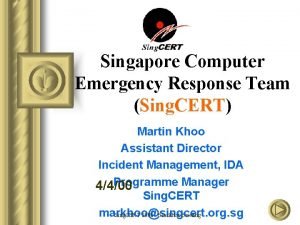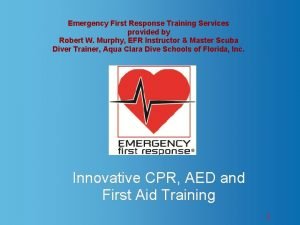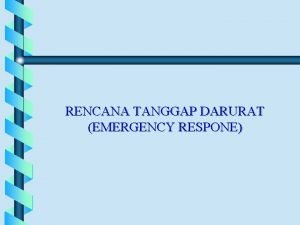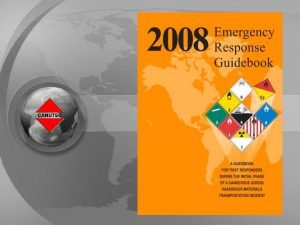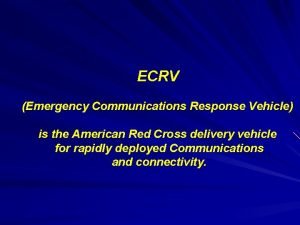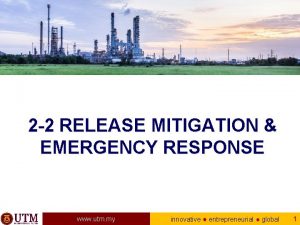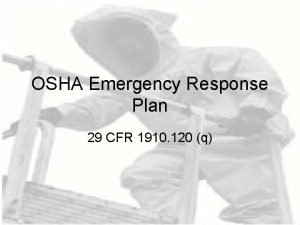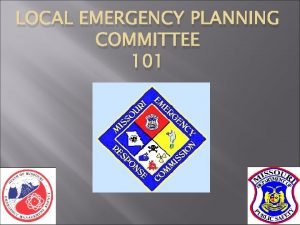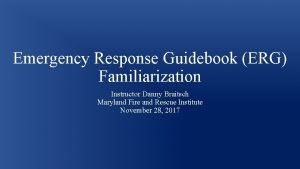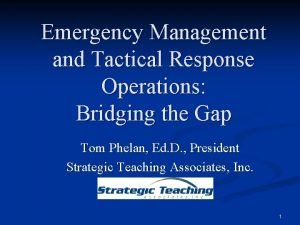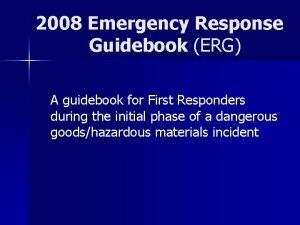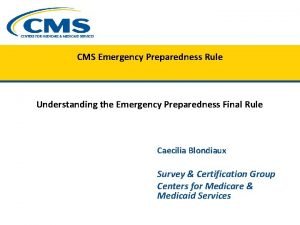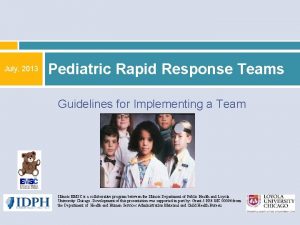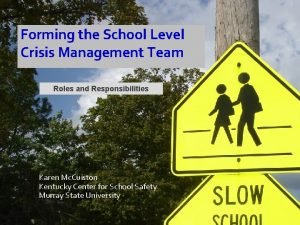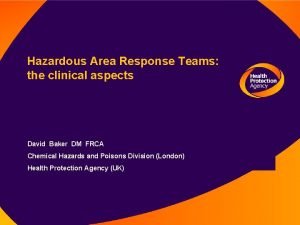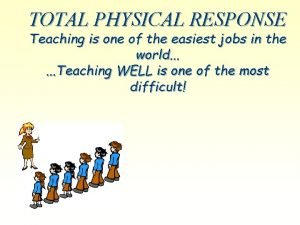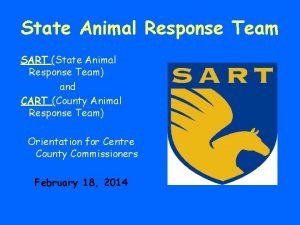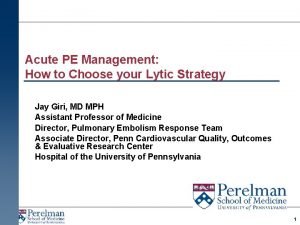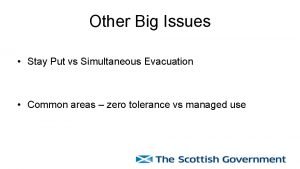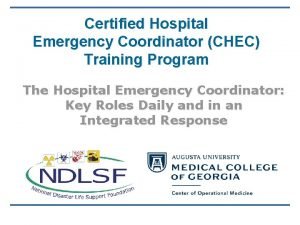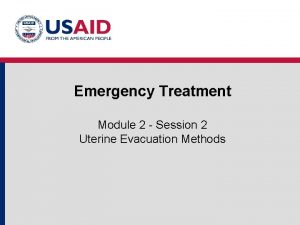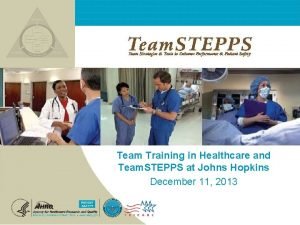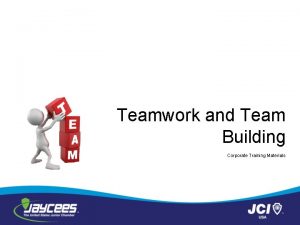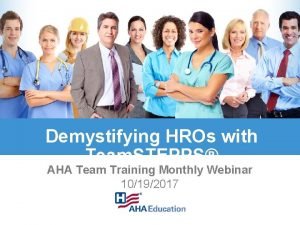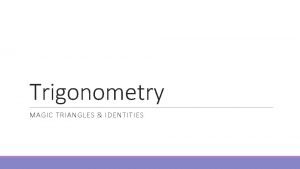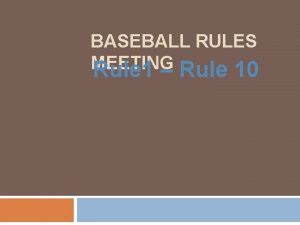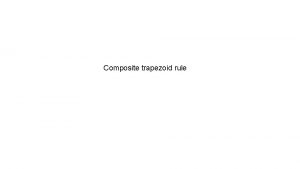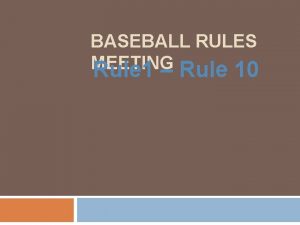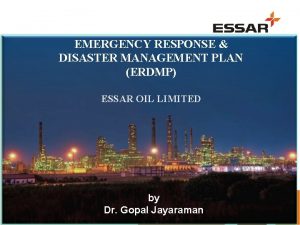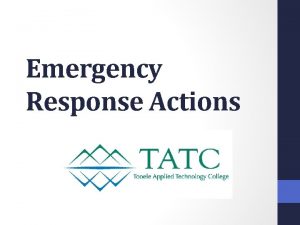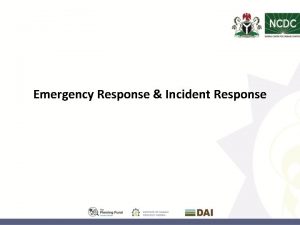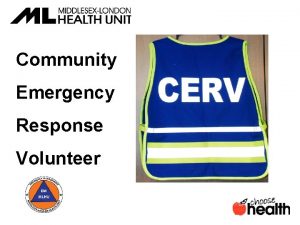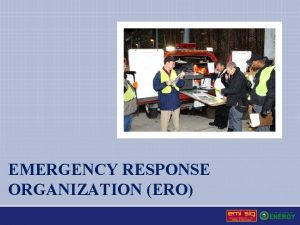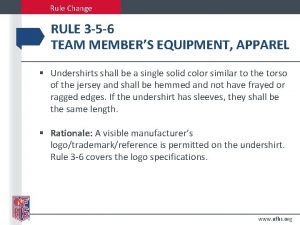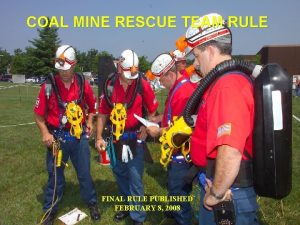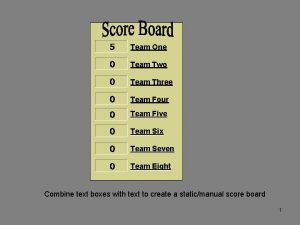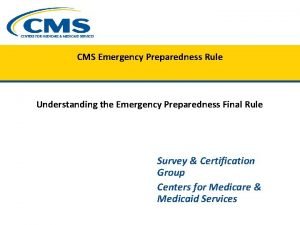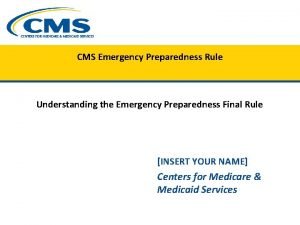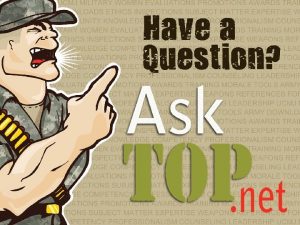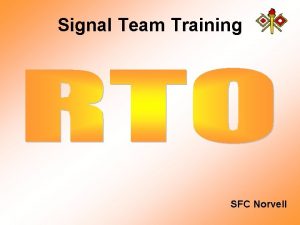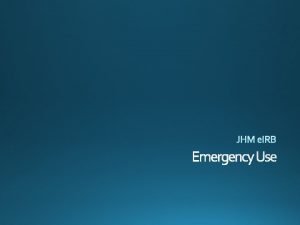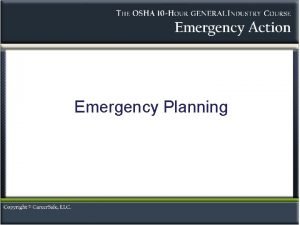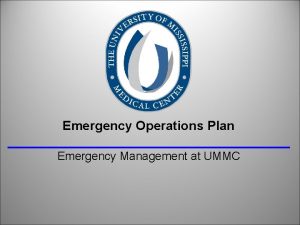Emergency Response Team Training Rule 59 Emergency Response






































- Slides: 38

Emergency Response Team Training Rule 59 - Emergency Response to Life-Threatening Asthma and Severe Allergic Reaction (Anaphylaxis) August 2016 1

At the conclusion of this training ERT members will be able to: � Define life-threatening asthma and anaphylaxis � Describe the signs/symptoms of life-threatening asthma and anaphylaxis � List the steps to be taken in an emergency, as outlined in the protocol � Identify the Nebraska medication administration competencies � Demonstrate how to use an Epi. Pen® � Demonstrate how to administer a nebulized albuterol treatment � Document pertinent information on the Emergency SHORT Report and Emergency Report Form � Complete the written test and receive a Documentation of Competencies form 2

Emergency Response to Life-Threatening Asthma or Systemic Allergic Reactions (Anaphylaxis) Rule 59 Protocol � Omaha, NE – late 1990’s – asthma deaths at school � Purpose – to save the lives of those suffering from asthma and LTA (life-threatening allergy) who are undiagnosed and do NOT have a plan or medications at school � This protocol DOES NOT replace a diagnosed child’s asthma/allergy action plan or medications

Emergency Response Team (ERT)Training � Every Nebraska school is mandated to adopt the Rule 59 Protocol and to be prepared to respond to a life-threatening breathing emergency due to asthma or anaphylaxis � AIRE Nebraska, the organization supporting this mandate, recommends that there be, at least, 3 CPR certified staff in each building where students are present to carry out the Emergency Response to Life-Threatening Asthma or Systemic Allergic Reaction (Anaphylaxis) protocol � Civil liability immunity is provided by Neb. Rev. Stat. 25 -21, 280 which states that staff members responding to a breathing emergency will not be liable for civil damages when following the steps of the protocol 4

2015 -16 Review � � 55 voluntarily reported incidents 0 deaths! � 58% (32) had a history of asthma – only 50% of these students had a plan/medications at school - 40% returned with plan/medications! � 24% (13) had a history of severe allergy – only 23% of these students had a plan/medications at school – 46% returned with plan/medications! � 29% (16) had no history of asthma/severe allergy – 31% returned with plan/medications! � 33% of all incidents (18) included a medication error

What Is Asthma? � Asthma is a lung disease caused by increased reaction of airways to stimuli, and can be life threatening � Asthma is a chronic (life-long) disease, with symptoms that may come and go and is often related to allergies 6

What is happening during an asthma attack? � Airway inflammation – the airway lining becomes red, swollen and narrow � Bronchoconstriction – the muscles that encircle the airway tighten/spasm � Airway obstruction – as the airway tightens and narrows, it can be very difficult to get air in and out of the lungs Airway hyperresponsiveness – the muscles that encircle the airway respond more vigorously and quickly to smaller amounts of allergens and irritants Secretions (mucus production) within the airway lining increases http: //bcove. me/earhv 5 jv Mayo clinic animation 7

Signs and Symptoms of an Asthma Attack � � � � Coughing Wheezing Difficulty breathing or shortness of breath Chest pain, heaviness or feeling of tightness Rapid breathing Tired, no energy, “hitting the wall May feel or act anxious Blue or grayish tinge to lips or nailbeds Gallagher 2002 8

Severe Allergic Reaction (Anaphylaxis) � Anaphylaxis is a medical emergency caused by an acute systemic (whole body) allergic reaction characterized by bronchial inflammation and constriction, and vascular collapse � Symptoms occur within minutes or up to 2 hours post-exposure; rarely—up to 4 hours later � Can occur with no previous allergic reaction � Greater risk for individuals with asthma, hay fever, or eczema 9

Symptoms of Anaphylaxis � Hives; Swelling of tissue around the face / lips / eyes � Itching: skin, mouth, throat � Anxiety – sense of doom � Nausea / vomiting / diarrhea � Sneezing and coughing � Difficulty swallowing � Shortness of breath / wheezing � Low blood pressure 10

Nebraska Medication Administration Competencies The competencies include recognition of: 1. Recipient’s right to privacy and confidentiality; 2. Recipient’s right to refuse; 3. Hygiene and infection control standards; 4. Appropriate policies/procedures for medication storage and handling; 5. General unsafe conditions; 6. Accurate documentation standards; 7. The five rights of medication administration; 8. Specialty needs of recipients; 9. Adverse reactions; 10. Safe medication provision for the oral, topical, inhaled or instilled routes; 11. The legal limits of the medication aide role; 12. Reporting responsibility for suspected adult abuse; 13. Reporting responsibility for suspected child neglect or abuse; and 14. The Recipient’s property rights and physical boundaries. 11

Medication Administration Competencies The ERT is responsible to give the Right drug to the Right recipient in the Right dosage by the Right route at the Right time. 12

Medication Error � � What is a medication error? • A medication error refers to an error (of commission or omission) at any step along the pathway that begins when a clinician prescribes a medication and ends when the patient actually receives the medication. Agency for Healthcare Research & Quality Usually involves an error in one of the 5 rights: right patient, right drug, right dosage, right time, and right route – some articles add right reason

Medication Errors and Rule 59 Protocol • Administered school’s albuterol only & not calling 911 • Administered school’s Epi. Pen® and then stopped…student breathing fine now • Administered the student’s auto-injectable epinephrine according to student’s action plan and followed by administering school’s albuterol • Administered school’s albuterol followed by school’s Epi. Pen® • Administered wrong dose of Epi. Pen®

In an EMERGENCY! Follow the steps of the protocol as a TEAM – someone calling, someone administering medications, someone documenting emergency on emergency SHORT report or emergency report form 1. Call 911 2. Summon school nurse if available. If not, summon designated ERT to implement emergency protocol Check airway patency, breathing, respiratory rate, and pulse Administer medications (Epi. Pen® and albuterol) per standing order Determine cause as quickly as possible Monitor vital signs (pulse, respiration, etc) Contact parents immediately and physician as soon as possible Any individual treated for symptoms with epinephrine at school will be transferred to medical facility 3. 4. 5. 6. 7. 8. 15

Step 1 of Protocol: Call 911 � Advise 911 that you are administering epinephrine and albuterol and believe this is a life-threatening breathing emergency

Step 2 of Protocol: Summon School Nurse and/or ERT � Each building needs to have a plan in place for alerting the nurse or ERT � Each staff member in the building needs to know how to alert the nurse or ERT � Each member of the ERT needs to know their role in responding (who is going to get the bag? who is going to manage the phone? who is going to document? ) 17

Step 3 of Protocol: Check ABC’s Airway – Is airway open or obstructed? Breathing – Are they still breathing? Look, listen and feel. How fast are they breathing? Circulation – Can you find a pulse, body movement? Are they conscious? 18

Step 4 of Protocol: Administer Epi. Pen® & Albuterol � Administer an IM Epi. Pen® Jr. for a child less than 50 pounds or an adult Epi. Pen® for any individual over 50 pounds � Follow with nebulized albuterol (premixed) while awaiting EMS. If not better, may repeat times two, back-to-back � If indicated, administer CPR 19

Administer Epi. Pen® � Epinephrine is the medication of choice for treatment of anaphylaxis and life-threatening asthma. � An Epi. Pen® is a disposable, pre-filled automatic injection device designed to deliver a single dose of epinephrine � It reverses the body’s reaction and reduces swelling and congestion in the lungs � Quick treatment with epinephrine is the safest approach, even if it may have been unnecessary � An unnecessary dose of epinephrine should have no prolonged or significant ill effects on an adult or child 20

Directions for Epi. Pen® Administration � Never put thumb, fingers or hand over the orange tip � Grasp unit, with the orange tip pointing downward � Form a fist around the auto-injector (orange tip down) � � With your other hand, pull off the blue safety release Hold orange tip near outer thigh � Hold the leg firmly in place while administering the injection � Swing and firmly push into outer thigh so that auto-injector is at a right angle to the thigh � Hold firmly in thigh for approximately 3 seconds � Remove auto-injector from thigh (the orange needle cover will extend to cover needle) and massage injection area for 10 seconds � Note the time the dose is injected and give used auto-injector to EMS. � Continue steps of protocol by following epinephrine injection with albuterol treatment. 21

Things To Know about the Epi. Pen® • The auto-injectors are designed to be administered through clothing (including jeans) • Apply to thigh, regardless of what body part is affected • In the unlikely event of a “needle-stick” to the individual administering an Epi. Pen®, consult and follow the school’s exposure control plan 22

After Epinephrine…. . “Children with symptoms of anaphylaxis should be placed in a recumbent position with their legs elevated. Because cases of sudden death have been reported in children who stood up during a severe reaction, the recumbent position should be maintained. If symptoms persist or progress, epinephrine can be repeated after 5 -15 minutes. In up to 20% of the cases of anaphylaxis, biphasic reactions occur. Therefore children who under-go food-induced anaphylaxis and receive epinephrine should be transported by ambulance to an emergency facility. ” Lancet, July 2013

Administration of Nebulized Albuterol � Albuterol relaxes the bronchi, helps open the airway, and moves the mucus out of the lungs. � A nebulizer is a machine (compressor) that mixes the medication with air to provide a fine mist (aerosol) for breathing in through a mask or mouthpiece. This is the most efficient way to get the medication into the lungs during an emergency (better than a metered-dose inhaler). 24

Directions for Administration of Nebulized Albuterol � � � Set up nebulizer as demonstrated by your instructor Instruct/assist student to assume seated position Place mask over mouth and nose. As aerosol begins to flow, instruct to inhale deeply and slowly through mouth, then exhale slowly If coughing occurs during treatment, remove mask. Allow individual to clear secretions completely; resume treatment Monitor individual for changes in respiratory rate, effort, and vocal ability If individual continues to have difficulty breathing, administer two more treatments 25

Step 5 of the Protocol: Determine cause as quickly as possible � You may not know the exact cause of a sudden allergic reaction or asthma attack, but this should not keep you from providing care � Ask questions. Any information you get can be passed on to the rescue unit � Always be aware the victim’s condition can worsen rapidly – do not leave victim alone or unobserved at any time! 26

Step 6 of the Protocol: Monitor Vital Signs � Continue to monitor breathing – is person still breathing? Look, listen and feel. How fast are they breathing? � Continue to monitor for signs of circulation-such as pulse, movement and conscious behavior � If indicated, administer rescue breathing or CPR 27

Step 7 of the Protocol: Contact parent immediately � ERT member responsible for communications should: • call 911 - give age, gender of victim, location, nature of emergency, medications administered, is victim conscious, etc • call the parent/guardian when possible 28

Step 8 of the Protocol: Any individual treated for symptoms with epinephrine at school will be transferred to medical facility � Effects of epinephrine will last only 15 -20 minutes � To avoid relapse without additional epinephrine available, person should seek medical care immediately � To return to school environment, person should have medical clearance, current signed asthma/allergy action plan and medication 29

Situation: A student with no known allergy is clutching their throat after eating in the cafeteria and says their throat is itchy and reports that it is hard to swallow � If the student/staff/visitor has no action plan/medications and displays signs and symptoms of a life-threatening breathing emergency: Administer the Emergency Response to Life-Threatening Asthma or Severe Allergic Reactions (Anaphylaxis) protocol 30

Situation: A student diagnosed with asthma is having difficulty breathing after running the mile for PE � Does this student have an asthma/allergy action plan? � Does this student have medication at school as part of the asthma/allergy action plan? � Are the symptoms relieved by following the action plan? � If the student has no action plan OR following the use of their personally prescribed medications according to their action plan does not relieve symptoms or the symptoms return or get worse: Administer the Emergency Response to Life-Threatening Asthma or Severe Allergic Reactions (Anaphylaxis) protocol 31

Supplies The following medical supplies are required for each building: • Container for emergency supplies (labeled “Emergency Use Only”) • Epi. Pen® and/or Epi. Pen® Jr. per weight • Nebulizer compressor with masks and tubing • Albuterol(premixed) - three vials per building 32

Supplies The following supplies are recommended to be included in the emergency bag: l Pen and paper l Emergency SHORT Report or Emergency Report Form l Protocol skills card and CPR skills card l Gloves l CPR face shield l 4 x 4 Gauze squares l Student health alert information l Monthly medication monitor sheet 33

Care, Storage & Disposal of Medication � Medication must be monitored, kept current and disposed of appropriately � Medication should be stored in a safe area AND be accessible to ERT � Epi. Pen® and albuterol must be kept at a controlled room temperature (59 -86°F), protected from light, freezing or extreme heat. Do not refrigerate � Check for color of drug: Epi. Pen® – replace if solution is brown, pink or contains precipitate Albuterol – do not use solution if it is brown, pinkish, darker than slightly yellow or contains precipitate (particles in solution) � Monitor medication monthly for expiration date and appearance � Never place Epi. Pen® in the regular trash. All expired Epi. Pen® should be disposed of in sharps container. If none available, take to medical facility for proper disposal 34

Documentation � Designate ERT member to complete documentation � NEW Emergency SHORT Report! Keep copies in emergency bag. Fill out at time of emergency, copy, keep one and hand one to EMS. Use this to complete Emergency Report Form which is more in-depth � Emergency Report Form to be completed whenever the emergency protocol is implemented � Send completed copies to the supervisor of the school’s health services program and district administration, physician (with written parental consent), student’s school health record and AIRE Nebraska (To protect confidentiality, the copy sent to AIRE does not contain the student’s name) 35

When it’s NOT a life-threatening emergency NOT every asthma flare is a life-threatening breathing emergency – if you do not believe the person is going to die, do what you would normally do – call the parent/guardian, inform them, monitor the person and do not leave them alone DO NOT administer nebulized albuterol before administering the Epi. Pen®! Doing this can be dangerous for the patient and puts you at risk for a lawsuit 36

Homework What is the plan for your building? • How will your staff notify the ERT that they need assistance? • Who will grab the bag with medications/equipment? • Who will document the incident? • Who will direct the EMS response to the patient? • Run a drill – what can you improve upon? Don’t forget to notify ALL school staff of who is on the ERT and what the plan is for your building!

REMEMBER… No one should die from an asthma attack or severe allergic reaction! 38
 Sing cert
Sing cert The importance of training
The importance of training Going native project management
Going native project management Team spirit becomes team infatuation
Team spirit becomes team infatuation The white team cheers for the blue team, just like
The white team cheers for the blue team, just like Rencana tanggap darurat
Rencana tanggap darurat Orange guides refer only to non-highlighted substances
Orange guides refer only to non-highlighted substances Objectives of reliance industries
Objectives of reliance industries Emergency communications response vehicle
Emergency communications response vehicle Utm emergency response plan
Utm emergency response plan 1910-120
1910-120 Missouri emergency response commission
Missouri emergency response commission Erg green section
Erg green section Emergency disaster tactical response
Emergency disaster tactical response Emergency response guidebook yellow section
Emergency response guidebook yellow section Walmart emergency response system
Walmart emergency response system Emergency response plan
Emergency response plan Emergency response tool
Emergency response tool Cms emergency preparedness rule
Cms emergency preparedness rule Srrt team
Srrt team Pediatric rapid response team
Pediatric rapid response team Crisis management team responsibilities
Crisis management team responsibilities Hazardous area response team
Hazardous area response team Physical response team
Physical response team Pennsylvania state animal response team
Pennsylvania state animal response team Ekos ultrasound
Ekos ultrasound Simultaneous evacuation
Simultaneous evacuation Chec certification
Chec certification Emergency evacuation training
Emergency evacuation training Stepps healthcare
Stepps healthcare Team building training module
Team building training module Aha team training
Aha team training Natural and forced response
Natural and forced response First order system transfer function
First order system transfer function Primary immune response and secondary immune response
Primary immune response and secondary immune response Special triangle
Special triangle Sine rule obtuse angle
Sine rule obtuse angle Sohcahtoa practice
Sohcahtoa practice Kirchhoff's junction rule
Kirchhoff's junction rule
